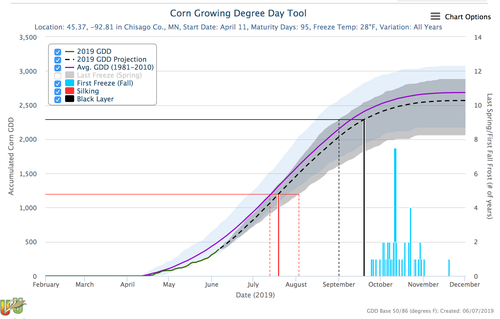June 7, 2019

The Corn Growing Degree Day decision support tool allows one to choose any Corn Belt county, enter the planting date and hybrid maturity, and generate a graph that shows projected GDD accumulations through the season, including the date on which you can expect that hybrid, planted on that date in that county, to mature (achieve black layer). One important adjustment missing from this tool is the fact that planting corn late usually lowers the GDD needed to get a hybrid from planting to maturity. In an article on his website, Dr. Bob Nielsen at Purdue includes a calculator that adjusts the GDD requirement downward based on how late planting actually is. This is not a trivial adjustment: planting a hybrid on June 10 (vs. May 10) lowers the GDD requirement by more than 200 GDD. So a hybrid that needs 2,700 GDD to mature if planted on May 1 will require an estimated 2,428 GDD if planted on June 10 (using Dr. Nielsen’s calculator). The revised GDD number can be manually entered into the GDD tool instead of days RM for the hybrid.

To get started on the tool, click where your farm is located in the county of interest (GDDs are calculated based on longitude and latitude) then select the graph tab. As an example, a 108-day RM hybrid (which the tool estimates will need 2,600 GDD from planting to maturity) planted on June 10 in Wood County, Ohio is projected to mature sometime after Dec 1 (the frost date is estimated at Oct. 29). However, if you manually change the expected layer GDD requirement from 2600 to 2328 (estimated using the calculator above) the GDD tool estimates that hybrid would achieve maturity by about Oct. 8 (nearly three weeks before the first average freeze).
If we change the planting location to Wayne County, OH, using the same hybrid and planting date and make the appropriate input changes to the GDD tool regarding reduced GDD requirements for a delayed planting, the GDD tool estimates that the hybrid wouldn’t achieve maturity until November 7 (average frost date of Oct. 27). Changing to a 102-day hybrid there would move projected maturity to October 9.
Source: Ohio State University
The source is solely responsible for the information provided and is wholly owned by the source. Informa Business Media and all its subsidiaries are not responsible for any of the content contained in this information asset.
You May Also Like




